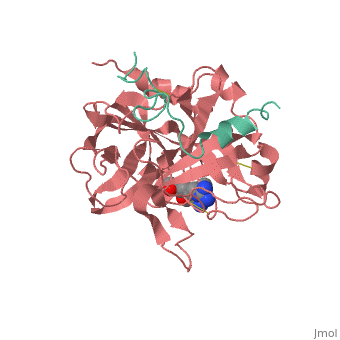Ann Taylor 115
From Proteopedia
Samer Kawak and Seth BawelSerine proteases, or proteinases, so called due to the presence of a serine residue in the active site, are a class of enzymes that catalyse the hydrolysis of peptide bonds in proteins. ThrombinThrombin is a "trypsin-like" serine protease. Its structure (PDB code 1ppb) is shown here with a peptide chloroketone inhibitor (PPACK). The thrombin A chain (cleaved N terminal fragement) is shown in cyan and the B chain is shown in red. The is made up of a catalytic triad of Ser195, His57 and Asp102, backed up by Ser214. The peptide chloroketone inhibitor (PPACK) is shown in purple. A closeup shows the at which the sidechain of Asp194 makes a salt link with the N-terminus at residue 16, newly formed when the A chain is cleaved in the zymogen-to-enzyme activation process. The specificity pocket is on one side of the throat of the domain 2 beta barrel, and the activation site is close next to it. The B chain consists of . As is true for all of the "trypsin-like" serine proteases, each of the two thrombin domains consists mainly of a 6-stranded, antiparallel beta barrel. The specificity pocket (here filled with the Lys sidechain of the PPACK inhibitor) is in one side of the throat of the domain 2beta barrel, and the activation site is close next to it. Trypsin-BPTI complexThe trypsin backbone is shown in pink and the trypsin inhibitor, BPTI, in yellow (PDB code 2ptc). The residues [Ser195-His57-Asp102-Ser214] are shown in green, the disulfide bond between residues 14-38 is shown in yellow and the Lys 15 sidechain at the specificity site in pink. succinyl-AAPK-trypsin acyl-enzymeThe atomic resolution structures of trypsin acyl-enzymes like suc-AAPK-trypsin, a tetrahedral intermediate analong, and the Michaelis complex make up the recreation of the catalytic cycle of the serine protease. In a 2006 study by Koshland et al., a model of suc-AAPK-trypsin was studied at 1.28 Å resolution, which exhibited an acyl-enzyme occupancy of 70% with the residual 30% of trypsin extant in free enzyme form. [1] In suc-AAPK-trypsin, the substrate binds near Ser-195 and His-57. His-57 displays two conformations with equal occupancy. The first conformation positions His-57 near Ser-195 and within hydrogen bonding distance of a water molecule. The water molecule is positioned between His-57 and the acyl carbonyl carbon. In this position, the water molecule is poised for hydrolytic attack. His-57 deprotonates water, turning the water molecule into a better nucleophile. The water molecule is already positioned to directly attack the acyl carbonyl carbon. The rotates His-57 around the alpha and beta carbons, away from Ser-195 and out of hydrogen bonding distance with the water. This conformation shift takes His-57 out of play. The conformation flexibility of His-57 may be involved in substrate binding or release. [1] Content Donators
| ||||||||||||
Reference
[1] Radisky, E.S., Lee, J.M., Lu C.K., and Koshland, D.E., Jr. Proc. Natl. Acad. Sci. USA 2006, 6835-6840.

